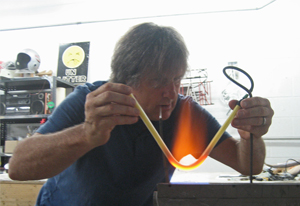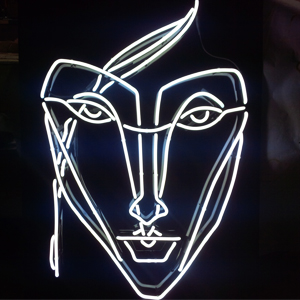Surviving the LED era
In 2002, light-emitting diodes (LEDs) began to emerge as an alternative to neon illumination of channel letters and box signs.
 “At the beginning, they were very expensive and burned out quickly, but their development and acceptance accelerated,” says Farrell. “Before, sign companies could upsell neon because it was high-voltage and had to be handled by skilled installers. With LEDs, though, practically anyone can install them.”
“At the beginning, they were very expensive and burned out quickly, but their development and acceptance accelerated,” says Farrell. “Before, sign companies could upsell neon because it was high-voltage and had to be handled by skilled installers. With LEDs, though, practically anyone can install them.”
As the sign industry moved toward LEDs and their lower labour requirements over the ensuing years, Hope Neon had to lay off staff—to the point where today, Farrell is the only one left and he has subleased the back half of his shop to an engineering firm. Hope Neon is again a one-man shop, as at its inception, with Farrell turning to outside installers only when a large project requires a crane.
“There were quite a few years where we didn’t make money,” he says. “We kept downsizing and I had to hang in. I started to focus on exposed neon, which had always been out there, but was a market we hadn’t really served before. At the height of our business with neon in channel letters and sign boxes, I would say exposed neon had only accounted for about five per cent of our sales.”
Again, the timing was right for a business transition. Restaurateurs seeking a retro look turned to artists like Farrell, both to refurbish old signs and to make new ones look aged. Skeletal neon installed directly on indoor brick walls became very trendy. Classic-style signs were commissioned for TV commercials and series. And exposed neon even became ‘in’ for branding corporate reception rooms.
“I also have a lot of artists coming to me with sketches,” says Farrell. “I redo their art in neon and then they take it on to gallery shows. And before Christmas every year, I get orders for personalized neon signs as gifts from women to their husbands for their ‘man caves.’”
Ironically, the widespread adoption of LEDs for signage has indirectly helped keep Hope Neon in business by providing alternatives.
“A lot of people don’t like those signs where LEDs are used to mimic exposed neon,” says Farrell. “Neon has more of a classic look and offers a wider range of brilliant colours. Also, customers are starting to understand the question of energy efficiency is overrated. If you want the same light output, the difference in electrical consumption is minimal; LEDs are about 10 to 15 per cent more efficient, which for the size of projects I work on is pennies per month. So while it’s nice that exposed neon is the ‘in’ style again, I think the demand will always be there. And when the economy slows down, retailers will still want neon in their windows to attract customers.
 A neon renaissance
A neon renaissance
The aforementioned El Mocambo sign restoration was a milestone for the new, leaner Hope Neon, as it provided a solid reference and led to other projects.
In 2013, Farrell restored a series of outdoor exposed neon signs for The Music Hall, another storied concert venue on Toronto’s Danforth Avenue. He worked on a 1950s look for Coasters, a nostalgia-themed diner at Canada’s Wonderland, an amusement park just north of the city in Vaughan, Ont. His neon lettering can be seen on the inside walls of several Mexican restaurants in downtown Toronto, including La Carnita and Playa Cabana, and outside Chinese restaurant Dai Lo. And he continues to work for Grosso’s Cadillac Lounge.
“I’ve repaired their exterior signage again and again,” he explains, “and I’m going to redo it soon. With a lot of old signs, they can be rewired so there’s less strain and less electrical arcing.”
West Queen West has also led Farrell farther afield. The Drake Hotel, credited with spurring Parkdale’s commercial renaissance as an entertainment district when it was renovated and reopened in 2004, recently expanded its business with the opening of The Drake Devonshire, a more bucolic location in Wellington, Ont., on September 15.





